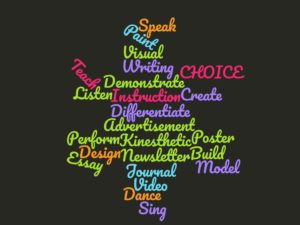By Taru Nieminen December 21, 2016
 I still remember the first time I gave my students choice products instead of a test at the end of a unit. There was amazement from all of us. Students were amazed that they could choose and I was amazed that this was the first time they had a choice in finishing exams.
I still remember the first time I gave my students choice products instead of a test at the end of a unit. There was amazement from all of us. Students were amazed that they could choose and I was amazed that this was the first time they had a choice in finishing exams.
The classroom was abuzz with blank stares, looks of astonishment, shifty eyes looking at each other in disbelief, and oohs and aahs.
When you give students choices, they feel like they’ve “pulled the wool over your eyes.” It’s a beautiful feeling when you pretend that they have.
Creating “Products”
When creating the products for your subject, ensure that you select one for each of the communication facets: writing, reading, speaking and listening as well as selecting kinesthetic and visual activities. Although this video doesn’t offer all the above choices, this is a great way to start offering different product choices for your students to feel successful.
The suggestion is that you do not offer a plethora of choices. Limit choices to a maximum of four for short sessions/ lessons. You can even make it as easy as letting students choose answering either odd or even numbers for an activity. End of unit product choices should not exceed 10. Sometimes even that is too many. Choose carefully.
Two of The Most Important Things to Bring to Class
The most important aspect to remember when writing and creating product choices is to give students a rubric. Without a rubric, students do not know what to turn in. Many times, teachers have an idea of what they want students to create, but give no rubric. No rubric means you have no expectations.
The second way for students know what to turn in is to make or show examples. Even if students copy exactly what you created, they have done the work. And as the age-old saying goes: “Imitation is the greatest form of flattery.” Be flattered.
How to Come Up with the Choice Products
One of the easiest ways to generate product choices in to use the Common Core State Standards. Here is the CCSS Reading Standard for Literature – Grade 6 (Integration and Knowledge):
Compare and contrast texts in different forms or genres (e.g., stories and poems; historical novels and fantasy stories) in terms of their approaches to similar themes and topics.
For this standard, some of the options could include:
- Create a Venn Diagram to compare and contrast ___________ and ___________.
- Write two to three paragraphs while comparing and contrasting ____________ and _________.
- Illustrate a storyboard comparing and contrasting ___________ and ___________.
- Illustrate the similarities and differences of __________ and ___________ in a comic strip
- Write and perform a song/rap discussing the similarities and differences in _________ and _________.
- Write and perform a skit about the similarities and differences between ___________ and _________.
Essentially each student is still doing the same work, yet they can choose how to present the ideas (compare/contrast) they have gleaned from the texts.
Product Possibilities
Here are some more product possibilities. Any one of these can be used for any subject. You are the expert in yours, so tap into the creative side of your brain and give your students what they crave.
The possibilities are endless. Put your creativity to work. And remember to ask your students and colleagues for ideas – after all, two (or a dozen) brains are better than one.
|
Visual |
Kinesthetic |
Writing |
Speaking/ Listening
|
| · Draw a Venn Diagram | · Perform a Skit | · Write an Essay | · Write and perform a Song/ Rap |
| · Build a Model | · Perform a Dance | · Write a Letter | · Give a Speech |
| · Build a Diorama | · Create a Video | · Keep a Journal | · Create and show a Video |
| · Create a Game | · Create a Game | · Create a Newsletter | · Conduct an Interview |
| · Make a Puzzle | · Build a Model | · Write a Brochure | · Survey/ Results |
| · Drawing/ Painting | · Dramatization of… | · Create a Tri-fold | · Teach a Lesson |
| · Make a Poster | · Demonstrate a … | · Write an Article | · Lead a Discussion |
| · Draw a 3-D Map | · Simulate a/the… | · Write a Poem | · Debate an Issue |
| · Create an Advertisement | · Design and show… | · Tweet/Create Facebook Posts | · Perform a Role Play based on… |

